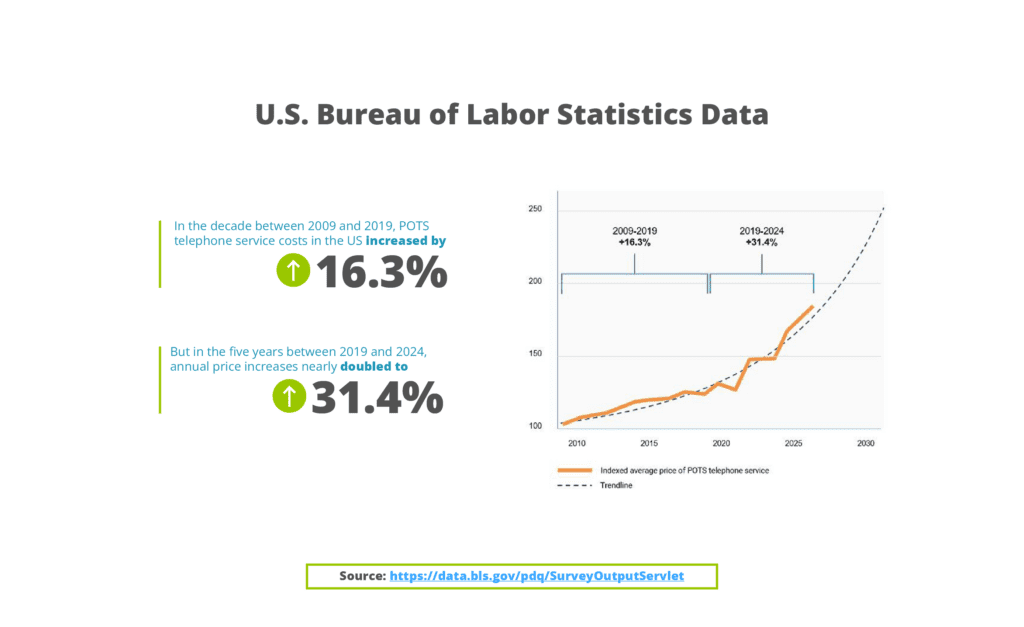It’s been four years since the communications landscape was forever changed by the landmark ruling by the FCC. Order 19-72A1 removed the mandate from local exchange carriers that required them to offer competitors access to the copper lines they owned at unbundled and regulated rates and legacy services for resale.
Why? According to the FCC release from 2019, they state: “The communications marketplace has transformed over the past twenty years, with consumers migrating away from plain old telephone service provided over copper wires by their local telephone company toward newer, any-distance voice services provided over next-generation networks by cable, mobile and fixed wireless, and over-the-top VoIP providers.” The FCC’s own published data at the time reported that out of the” nearly 455 million active voice subscriptions in the United States, only 55.8 million were provided by incumbent LECs.”
As we approach the five-year mark, we decided to compile this ultimate list of POTS Line Statistics:
Landline Decline and Communication Trends
- Active POTS Lines: Dropped from 122 million in 2010 to 36 million in 2021
- Worldwide Trend: Fixed telephone subscriptions have been declining since 2009
- U.S. Landline Subscriptions: 88 million in 2023, down from 94 million in 2022
- Historical Peak: 192,513,000 landlines in 2000
- Historical Low: 49,269,000 landlines in 1964
Household Communication Patterns
- 27% of homes still have a landline
- 73% of homes use only cell phones
- 2% of homes have a landline but no cell phone
- 1% of homes have neither landline nor cell phone
- 34% of homeowners have a landline
- Only 15% of renters have a landline
Age and Communication
- 88% of adults aged 25-29 use only cell phones
- 47% of adults over 65 use only cell phones
Demographic Insights
- No significant difference in cell phone usage based on education
- Income correlation:
- 78% of households below poverty line use only cell phones
- 72% of households above double poverty rate use only cell phones
Geographic Variations
- No significant difference between urban and rural cell phone usage
- States with highest cell-phone-only households (nearly 80%):
- Idaho
- Oklahoma
- Mississippi
- Wyoming
- New Mexico
- States with lowest cell-phone-only households:
-
- New York
- Maryland
- Massachusetts
- New Jersey
Cost and Infrastructure
- POTS line cost: $65-$100 per line
- POTS home phone service cost increased 40% since 2013
- Business POTS lines can cost hundreds of dollars monthly
- Copper wire networks are vulnerable to external damage
- Maintaining copper infrastructure is costly for service providers
Additional Note
- No correlation between landline ownership and computer/tablet presence in home
Conclusion: The Inevitable Evolution of Communication
As you can see this list of POTS Line statistics tell a compelling story of technological transformation. What was once a ubiquitous household fixture—the landline telephone—is rapidly becoming a relic of communications past. The dramatic decline from 192 million landlines in 2000 to just 36 million in 2021 reflects more than just a technological shift; it represents a fundamental change in how Americans connect.
The FCC’s 2019 ruling was less a cause and more an acknowledgment of an already ongoing revolution. Consumers have overwhelmingly chosen mobility, flexibility, and integrated communication technologies over traditional copper-wire telephony. This isn’t just about convenience—it’s about adapting to a world where communication transcends physical boundaries.
While some demographics, particularly older adults and residents of certain states, maintain stronger connections to landline technology, the trend is unmistakable. Cell phones have become the primary communication tool across income levels, education backgrounds, and geographic regions.
As we look forward, the complete phaseout of POTS lines seems not just probable, but inevitable. The infrastructure is expensive, vulnerable, and increasingly obsolete. The future of communication is wireless, digital, and infinitely more versatile.
Sources:








